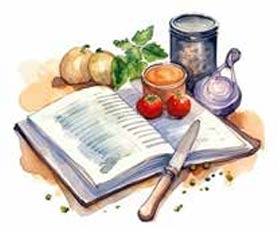Introduction
a recipe is an archive
Kelley Hummingbird-Klor, MLIS
Citizen of Cherokee Nation
Association of Tribal Archives, Libraries, and Museums
an invitation to culture and stories
Offering more than physical nourishment, food shapes our cultural identity and connects us as humans. Sharing a recipe extends an invitation to explore stories and cultural understanding.
Stories often accompany a dish, providing details of memories and occasions. These stories have an intergenerational impact on our identity and on those with whom we share our table and meals.
Food holds a transcendent power to carry us to another time and place through a simple taste or smell. It blends sensory experiences. It is an identity-building storyholder. The sights, smells, tastes, textures, and sounds associated with it connect the past, present, and future, intertwining them.
the sentimental significance of written recipes
Not only is a recipe a memento of the foods that nourished a family or community at a particular point in time and space, but it also holds its own memories and stories.
Some recipes can be exact, with precise measurements and instructions. Other recipes are more like guidelines, providing approximations and clues that require secret, intimate knowledge shared through other means to complete the dish.
Food holds a transcendent power to carry us to another time and place through a simple taste or smell. It blends sensory experiences. It is an identity-building storyholder. The sights, smells, tastes, textures, and sounds associated with it connect the past, present, and future, intertwining them.

For example, the “handful” of one ingredient elicits the memory of a relative’s hands. The “spoonful” of another ingredient invites us to a kitchen of yesteryear, and a favorite spoon used by a parent when making biscuits.
A faded written recipe card also records handwriting as unique and individual as the creator’s personality. The stains of drips and splatters on a heavily used recipe card can conjure the image of pulling up a chair to let a child help.
more than just ingredients and instructions
A recipe embodies culture, identity, and memory. It serves as an archive, preserving and sharing these elements to safeguard records of human experience.
These archives spark imagination. They help to build and preserve cultural identity and collective memory. They enliven our journeys, painting a vivid picture of our origins and shared human experiences.
Preserving cultural heritage is a primary goal in archival work, where professionals strive to protect and preserve heritage for future generations. In a world of migrations, conflict, and environmental change, the deliberate acts employed to protect heritage are more important than ever.
In a way, food is a miraculous connector, and one of the most simple ways to learn, express love and gratitude, and generate the happiest of memories.
A recipe can do all of this when used as a tool, and to continue to be used, it must be preserved and accessible.
sharing recipes in an ever-evolving culture
In an increasingly virtual world, we encounter challenges and opportunities in maintaining connections. Digital preservation capabilities enhance accessibility to culture.
Recipes are easy to find online. But many of us return to our own recipe cards and cookbooks because of the stories and memories they hold.
Recipes are easy to find online. But many of us return to our own recipe cards and cookbooks because of the stories and memories they hold.
The makers and contributors of this cookbook hope that the recipes and stories shared here serve as friendly invitations because this is how culture stays alive.
Culture is not static. It continuously evolves and expands. When we share stories and experiences, we ensure that culture moves forward.
to take away
As you read the stories and try the recipes in this book, we hope they inspire you to reflect on your own stories, foods, and family rituals. These are pieces of your cultural puzzle.
this is how culture stays alive
Consider the past, present, and future as you reflect on the foods of ancestors, their survival, and journeys. Savor the present moments - the smells, the tastes, and those who share our table, while passing on wisdom and traditions to the younger generation. This can all be achieved with a simple meal, perpetuating culture and contributing to a living and evolving archive for future generations.
From our family to yours, thank you for joining us at our table.

